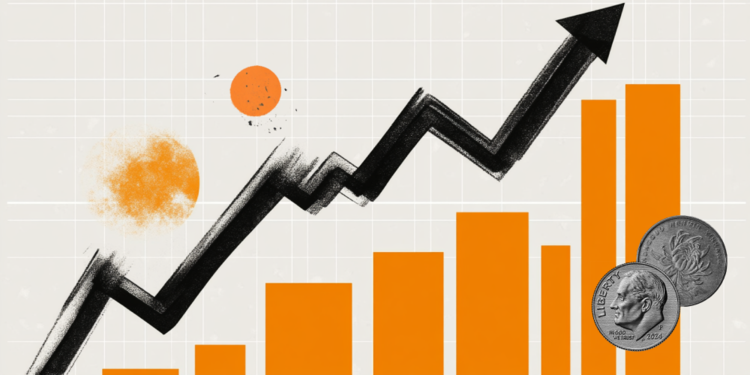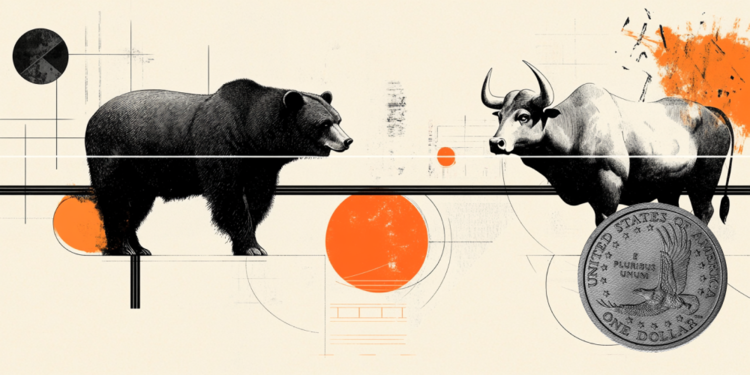- The US Dollar is moving mostly higher on Monday’s trading chart in the US session.
- Traders are likely to keep their powder dry for Wednesday’s main Fed event.
- The Dollar Index is above 105.00, struggling to reach new highs.
He US dollar (USD) continues its winning streak and possibly this week reaches its tenth consecutive rise. Despite the strength, some signs are beginning to accumulate that the recovery could come to an end. Although last week closed in the green for the dollar, the components of inflation expectations from the University of Michigan showed that participants believe that the US Federal Reserve (Fed) should be close to ending with the rise in interest rates – and this is not good news for the Dollar.
The week features a very light economic calendar that likely won’t have much impact at current levels. Some selling pressure is expected until Wednesday, especially if the Dollar fails to break higher. This means that the Dollar Index (DXY) is at risk of pulling back, moving slightly away from a new six-month high.
Daily summary: US dollar calms down
- Problems with the Euro: spreads between German and Italian 10-year bonds soar to 180 basis points, for the first time since June.
- Russia has deployed a MIG-31 aircraft to intercept an American plane flying over the Barents Sea – RIA mentions.
- Numerous central banks join the Fed this week, with the Swiss, Norwegian, Swedish, Japanese and British central banks set to issue rate decisions this week.
- Crude oil prices remain high on the board, as WTI crude oil touched a new yearly high at $90.84. The boost in oil prices could mean that headline inflation remains high in the next quarter.
- Monday’s agenda is very packed, in a week in which the focus of attention will be the decision on interest rates by the US Federal Reserve.
- The National Association of Home Builders publishes its housing market index for September, which goes from 50 to 45.
- The US Treasury Department will auction a 3-month bill and another 6-month bill.
- Stocks a bit mixed, with no clear direction on Monday. Some disappointing comments from Societe Generale, which have failed to impress investors, are putting some selling pressure on European bank holdings.
- CME Group’s FedWatch tool shows that markets are 97% pricing in the likelihood that the Federal Reserve will keep interest rates unchanged at its September meeting following the recent PPI and retail sales numbers.
- The 10-year US Treasury yield is trading at 4.35%, and peaked in early trading on Monday.
Dollar Index Technical Analysis: Keep your powder dry
The Dollar has had a bit of a bumpy ride, although economic conditions compared to Europe and other countries continue to make it stand out and shine. This causes investors to continue flocking to the Dollar due to the high rates paid to investors. The question for this week will be whether the Dollar Index can stay above 105.00 even if the Fed pauses rates.
The Dollar Index (DXY) has risen to 105.41 points. It is just a breath away from the 2023 high, near 105.88. If the DXY manages to close the week above this level, the Dollar is expected to strengthen further in the medium term.
On the downside, the 104.44 level seen on August 25 maintained support for the index on Monday, preventing further selling of the DXY. If the rally started on September 12 reverses and 104.44 gives way, a substantial pullback could occur to 103.04, where the 200-day SMA comes into play as support.
Central Banks Frequently Asked Questions
What does a central bank do?
Central Banks have the fundamental mandate of guaranteeing price stability in a country or region. Economies constantly face inflation or deflation when the prices of certain goods and services fluctuate. A constant rise in the prices of the same goods means inflation, a constant fall in the prices of the same goods means deflation. It is the central bank’s job to keep demand in line by adjusting its interest rate. For the largest central banks, such as the US Federal Reserve (Fed), the European Central Bank (ECB) or the Bank of England (BoE), the mandate is to keep inflation close to 2%.
What does a central bank do when inflation is below or above the expected target?
A central bank has an important tool to raise or lower inflation: modify its reference interest rate. At pre-communicated times, the central bank will issue a statement with its reference interest rate and give additional reasons why it maintains or modifies it (cuts or raises it). Local banks will adjust their savings and loan rates accordingly, which in turn will make it harder or easier for citizens to make a profit on their savings or for companies to borrow and invest in their businesses. When the central bank substantially raises interest rates, we speak of monetary tightening. When you reduce your reference rate, it is called monetary easing.
Who decides monetary policy and interest rates?
A central bank is usually politically independent. Members of the central bank’s policy council go through a series of panels and hearings before being appointed to a position on the policy council. Each member of that council usually has a certain conviction about how the central bank should control inflation and the subsequent monetary policy. Members who want a very loose monetary policy, with low rates and cheap loans, to substantially boost the economy, while settling for inflation slightly above 2%, are called “doves.” Members who prefer higher rates to reward savings and want to control inflation at all times are called “hawks” and will not rest until inflation is at 2% or just below.
Is there a president or head of a central bank?
Typically, there is a chair who leads each meeting, has to create a consensus between the hawks and the doves, and has the final say when votes need to be divided to avoid a 50-50 tie on whether to adjust current policy. The president will give speeches, which can often be followed live, in which he will communicate the current monetary stance and outlook. A central bank will try to push its monetary policy forward without causing wild swings in rates, stocks, or its currency. All central bank members will channel their stance toward markets ahead of a monetary policy meeting. A few days before a monetary policy meeting is held and until the new policy has been communicated, members are prohibited from speaking publicly. This is what is called the blocking period.
Source: Fx Street
I am Joshua Winder, a senior-level journalist and editor at World Stock Market. I specialize in covering news related to the stock market and economic trends. With more than 8 years of experience in this field, I have become an expert in financial reporting.







